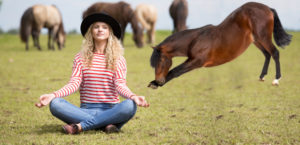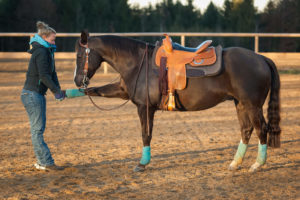
Light stretching is wonderful for our flexibility and elasticity, improved performance, and stress relief. In the same way, equines have stretches to benefit their bodies and performance, as well. Using stiff muscles adds stress to the joints and can result in injury. While equine and equestrian stretches are important, they can also be a fun bonding activity for you and your horse, even before the big event!
Before or after exercise?
Studies show that it is best to stretch after a workout, because the muscles are warm. Stretching after the ride can promote relaxation, and ensures warm and pliable muscles. Some riders choose to make stretching a part of their pre-ride warm up, after starting off with some light walking. Some riders massage the muscles to warm them, or use a warm towel to give the muscles some heat before stretching.Researchers say that stretching before exercise can impede performance, as well as increase the chance of pulling a muscle. Over-stretching is dangerous, and can result in soreness, muscle strain, and tendon damage.
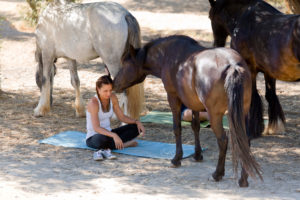
However, the benefits of proper equine stretching are incredible. It improves your horse’s circulation, reduces inflammation and muscle spasms, helps prevent injury, and promotes pain relief. It requires patience to ensure that your horse is assured that what you’re doing feels—and is—good. If you work slowly, it will increase their trust for you as you move their limbs. It will also help them relax those muscles instead of resisting your direction.
Stretching safety
Start easy. When your horse is relaxed and accepting of your touch, aim for a stretch that is 75% to 80% of the total stretching capability of the body part, and hold it for only 15 seconds. Stretch only in line with the joint and stay within your horse’s comfortable range of motion. Avoid twisting or sideways movements, and be sure to not bounce, jerk, or pull excessively on the limb. Only pull on the body part until you can feel mild tension.
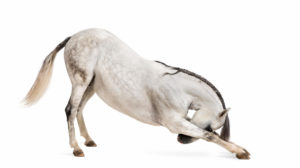
Once they get used to an easy stretch, you can hold it for longer—but no longer than a minute.
Equisearch warns to never tie your horse when you’re doing stretching exercises. They suggest stretching in an open area. “If you’re nervous about working with your horse untied,” the article points out, “you can have someone hold your horse with a halter and loose lead rope.”
The following stretches can improve the biomechanics and imbalances of equestrians on the horse; and can improve an equine’s flexibility and mobility.
1. Neck

Horse:
- Lateral Neck Stretches: Also known as “carrot stretches,” because you use a carrot or treat to guide your horse’s nose to go for the stretch.
- Facing your horse, stand on one side of them. Allow them to sniff the carrot or treat, and lead their nose to the ridge between their shoulder blades. Their hooves should be in place!
- Once they reach the desired degree, you can give them the treat!
- Repeat and then switch sides. (BONUS: Use the same technique to stretch their upper neck, leading their chin to their chest.)
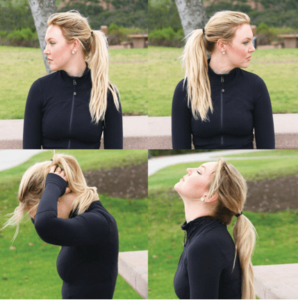
Rider:
- Neck Rotation: Your neck can move in six different directions: up and down, left to right, and side to side. Stretching all of these sides of the neck is wonderful for releasing tension.
- Shake out your shoulders and gently (and slowly) move your neck through its entire range of motion.
- Turn your neck from left to right, lower your chin to your chest and tip your head back as far as it will go.
- Finally, move your neck laterally left and right by bringing your ear to the corresponding shoulder.
2. Shoulders
Horse:
- Shoulder Extensions:
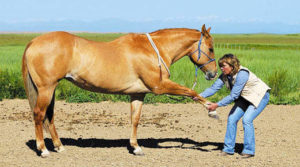
Courtesy of EquiSearch
- Face your horse and stand slightly to one side.Gently pick up your horse’s foot (the one on the side you are on), and place your other hand behind the same knee.
- Start to slowly back away from the horse, gently bringing the leg forward (but also keeping it low!)Then, slowly lift upward until you feel some tension, but make sure your horse is comfortable and not straining too much.
- Slowly return the leg back to its resting position. Repeat this process a couple or a few times. Then switch legs.
Rider:
- Pectoral Stretch: This arm rotation opens the shoulders and chest, and helps support a rider’s inner balance.
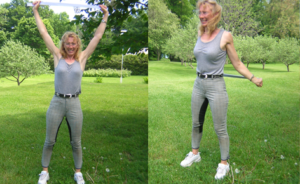
Courtesy of Horse Journals
- Holding a dressage whip or lead shank, raise your arms overhead and lower them behind your back.
- The tighter your shoulders are, the wider grip you will need.
- Be mindful of your shoulders, and how it would feel to maintain keeping them back while riding. Hold for 30 seconds. (BONUS:Increase the intensity of this stretch by narrowing your grip, or increasing the hold time.)
3. Back/Spine
Horse:
Tail/Back Stretches:A horse’s tail and the back are connected by the vertebrae and spine. By (lightly) pulling on the tail, the back will stretch. A horse with a sore back will clamp his tail and resist any upward tail movement, so be very attentive to your horse’s reaction. If a horse does clamp down their tail and refuses to budge, you can relax your horse’s tail by rubbing the hairless underside at the base of the tail for a moment.
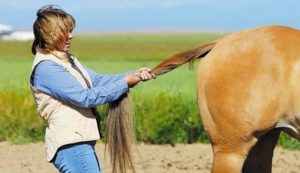
- Tail Pulls: For this stretch you will be standing an arm’s length behind your horse’s rear end. Thus, you must be aware at all times of your horse’s reactions to the stretch. This can be a very dangerous position, so ifyour horse shows any signs of anger, fear, or distress, forego this stretch until you’ve had more time to mentally and physically prepare him.
- Grasp the tail just above the end of the tail bone and visually align the tail with your horse’s spine.
- Slowly and gently pull straight out from your horse’s back, hold for a few seconds, and then slowly release.
- (Note: Releasing slowly is important because letting go quickly can put pressure on the tail, which can be uncomfortable for them.)

Courtesy of Dressage Rider Training–
Rider:
Bridge Glute Lifts: This stretch is great for your lower back and the bottom half of you, especially if you’ve been sitting for a long time. It is great for posture, and it can contribute to the success of your sturdy riding posture.
4. Hips
Horse:
- Hip Extensors/Stifle Flexor Stretch: A great stretch for horses that are short-striding.
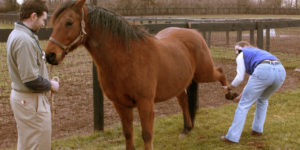
Courtesy of The Horse
- Stand next to your horse, and pick up their leg as though you are going to pick up their hoof.
- Place one hand on his fetlock, and hold his hock with your other hand.
- Pull his leg backwards past the tail (as well as forward toward the front limbs until it is fully extended.) Feel free to rest your elbows on your knees to support your back while holding the extended leg.
- Continue holding the extended leg until your horse leans into the stretch.
- To lessen the stretch, you can place both of your hands hind his fetlock.–
Rider:
- Lunge Stretch:Internal hip muscles get extremely tight from sitting down for long periods of time. Keeping your hips loose is crucial for dressage riders.
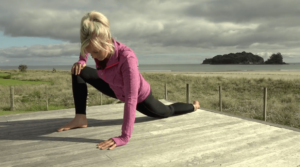
Courtesy of Dressage Rider Training
- Place your back foot on the ground, and drop the corresponding knee.
- Tuck in your pelvis and brace your core so you aren’t arching your back. Hold this for 2 minutes each side.
- As your range of motion improves, you can place your back foot up on a couch, chair, or table.
5. Legs
Horse:
- Foreleg Stretch:

Courtesy of Veterinary Holistics
- Stand in front of the leg you’re working with and pick up the horse’s foot, as though you were about to clean it.
- Place your hands on the leg between the fetlock and cannon bone, holding the leg in the palms of your hands.
- With your knees bent, lift up slowly. You must lift with your legs, and must keep the horse’s legs in line with his body.Be very careful to not pull it out to the side. When you lift, their shoulder blade will move up. Pause and count to three.
- Then lower the shoulder and slowly return the foot to the ground.
Rider:
- Couch Stretch:
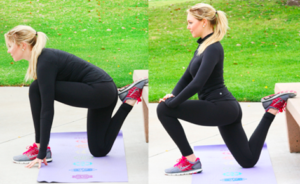
Courtesy of Intrepid International
- Begin on all fours with heels against the wall, knees slightly apart.
- Lift your left leg and place your knee against the wall.
- Place the foot of your right leg flat on the floor.
- Slowly raise your torso until you’re upright, in a neutral spine position. Make sure your hips are square to the front of the room. Only go as far as you can with this stretch. You may not be able to raise your torso at all when you begin.
- Switch sides and repeat.
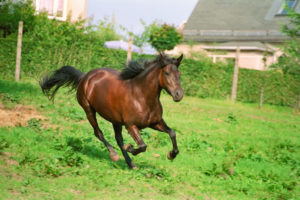 Whether your horse is retired or participates in the competition world, it is important to stretch them. Stretching lengthens and loosens stiff muscles back into their proper position, removing the stress on the joints, and helping to prevent injury. Similarly, an equestrian’s imbalance can negatively impact a horse’s performance—as well as the horse. Luckily, there are hundreds more equine and equestrian stretches— even apps— to help the cause for happier and healthier bodies.
Whether your horse is retired or participates in the competition world, it is important to stretch them. Stretching lengthens and loosens stiff muscles back into their proper position, removing the stress on the joints, and helping to prevent injury. Similarly, an equestrian’s imbalance can negatively impact a horse’s performance—as well as the horse. Luckily, there are hundreds more equine and equestrian stretches— even apps— to help the cause for happier and healthier bodies.
Consider joint health supplements for healthy joint tissue and flexibility for horses and people.
–

